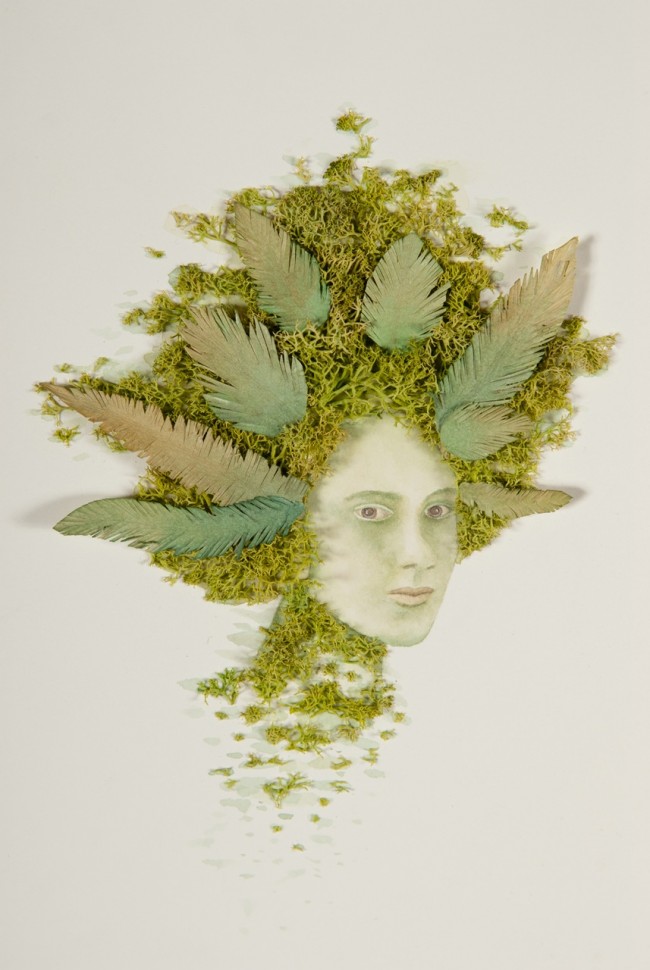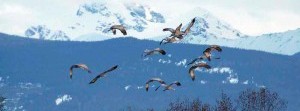
Deep Art: Creative reports from the wilds of Gwaii Haanas
The concept was simple: take several artists, remove them from their usual surroundings, and immerse them in the wildest parts of Gwaii Haanas—the rugged, mossy park that covers much of the remote southern end of Haida Gwaii. With only a guide and each other for company, this would promote an intense absorption with the landscape, deeply influencing the resulting artwork.
In June 2010, the Haida Gwaii Museum, in partnership with Parks Canada, launched its first-ever artists’ residency, and found it so successful that the program is being repeated this coming summer.
The original call for artists’ submissions was put forth in January 2010, with the idea of having a body of work created that had been directly influenced by Gwaii Haanas. “By creating art, inspired by their experience . . . artists can reveal meanings and relationships that complement the scientific and educational perspectives presented by park staff,” went last year’s application form. Thirty-five artists applied for the three available residency spots—nine islanders, 26 contenders from across Canada, and two international hopefuls. The lucky three were locals Tom Arnatt of Tow Hill and Betsy Cardell from Queen Charlotte, and Veronique La Perriere M. from Montreal. Each of these artists works in different mediums: Arnatt is a painter, Cardell works primarily in textiles and La Perriere M. explores mixed-media visual techniques.
Parks Canada has been bringing artists into parks for a few years now, in places such as Newfoundland’s Gros Morne National Park and Ivvavik National Park in the northern Yukon. The public is so used to hearing about the ecological significance of these reserved chunks of the country, and how the importance of habitat trumps any potential economic boon, that other kinds of meaning are often experienced on personal levels and not necessarily broadcast. By asking an artist to become totally saturated with the surroundings and create several pieces of artwork, internal explorations can be expressed in tangible ways for others to observe and relate to.
Breaking out
Gwaii Haanas’ residency program consisted of four stages: a pre-excursion art workshop presented by the off-island artist La Perriere M., the week-long foray into the park itself in mid-June 2011, a speaker-series presentation immediately after returning, and an exhibition in November at the Haida Gwaii Museum. The whole process was designed to bring artists out of their typical creative isolation, providing opportunities for collaboration and exposure to new techniques.
“I went there with the faith that I had something to learn from Haida Gwaii, its land and people,” says La Perriere M., a PhD student at Montreal’s Concordia University, whose research seeks to explore concepts of archive and memory through a variety of media. As the off-island artist, La Perriere M. facilitated the pre-trip workshop, which focussed on shadow puppetry. She had never visited Haida Gwaii (or even BC) before, but the appointment to the residency program somehow seemed meant to be.
“The winter before going to Haida Gwaii, and not knowing I will go there, I had started to draw mountains and mist,” she says. “I was surprised how those drawings seemed to be premonitory.”
Betsy Cardell, on the other hand, approached the residency from the completely opposite experience. She has lived on Haida Gwaii since 1975 and for many years worked on a fisheries vessel that travelled much of the area now making up the Gwaii Haanas reserve. “My perspective would be that of a long-time Haida Gwaii resident, revisiting places as an artist,” she says. Cardell, who works primarily with batik, applied for the program because she realized it was an incredible opportunity. “When I was informed that I was awarded a place as a Gwaii Haanas Artist, my reaction was pretty much stunned amazement,” she says. “When I learned who some of the other applicants were, I was very honoured to have been chosen.”
During their sojourn in the park, the three artists were guided by Parks employee Debby Gardiner, an artist herself who impressed the others with her boat-handling skills, her intimate knowledge of the area, and her ability to manage her charges—something Cardell compares to herding cats.
“She made sure we saw the maximum number of places, but also balanced the schedule so we had time to just look, get immersed in one place, and draw,” says La Perriere M. Each day, the artists wrote in journals, took photographs or film of their surroundings, and sketched. Some of these materials have become part of the residency archive, referential items that could be accessed for storyboards for the final exhibition. “We all produced work on-site,” adds Cardell. “We would talk and laugh and do performance art after dinner that was somehow connected to what was going on around us.”
Creative diversity
Considering that the artists travelled together and visited all the same sites, the works produced are all markedly unique. Arnatt’s pieces were both acrylic-on-canvas paintings; one, entitled Dejeuner Sur La Plage, embraces a delightfully vibrant surrealism. Cardell created two batiks and one ambitious work entitled Burnaby Narrows, a six-square-metre nuno-felted soft sculpture built on gillnet. La Perriere M. created an installation composed of drawings, archived objects from the museum storage (such as stuffed birds), and relics from her trip to the park. “I wanted to create a little universe that would echo my experience in Haida Gwaii and the different aspects that were marked for me,” she says. “The drawings were inspired by nature and moss and by a reflection on mythological tales.”
It’s easy, when one is there, to feel that Gwaii Haanas is a universe unto itself where time moves a little differently, and the echoes of a thousand years can still be sensed under layers of heavy moss. “I felt I had entered a different time-space,” says La Perriere M, speaking of World Heritage Site Skaang Gwaii, where a very few weathered totem poles still grace the ancient, abandoned village site. “It was a precious experience,” adds Cardell.
The park’s remoteness literally sets it apart from the rest of the world, and it is difficult for most people to access. In this way, asking artists to present representations of their experiences in the Park creates an opportunity for viewers on Haida Gwaii and beyond to tap into that personal, emotional level otherwise not communicated by educational Parks Canada literature. “Artist residencies are a wonderful way to create bridges and emotional links between different places and culture,” says La Perriere M. “I am now talking about Haida Gwaii in Montreal and exhibiting artworks that are inspired by this experience.”
The Haida Gwaii Museum and Parks Canada are so pleased with the result of last summer’s residency that a second residency is being planned for 2012, with requests for proposals intended to be out by March. “I would do this again in a heartbeat, but I feel very strongly that other artists should have their chance at this experience,” says Cardell. “I am telling all my artist friends, and any other artists who will listen, to apply for this opportunity of a lifetime.”



